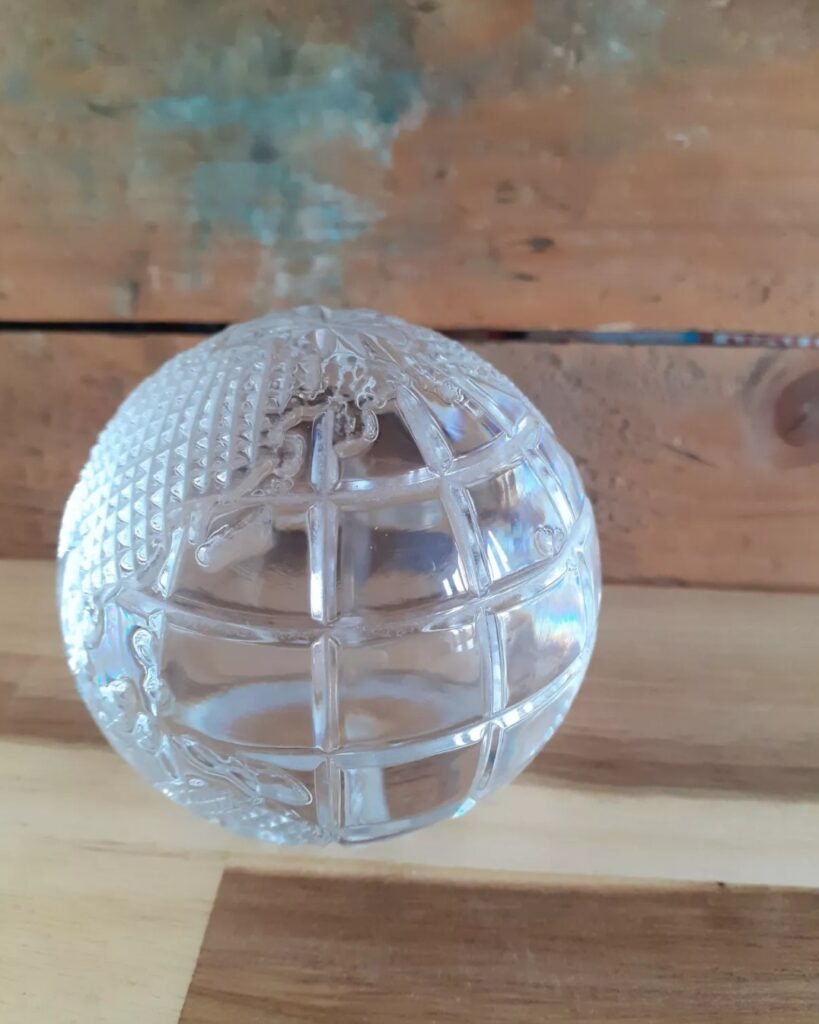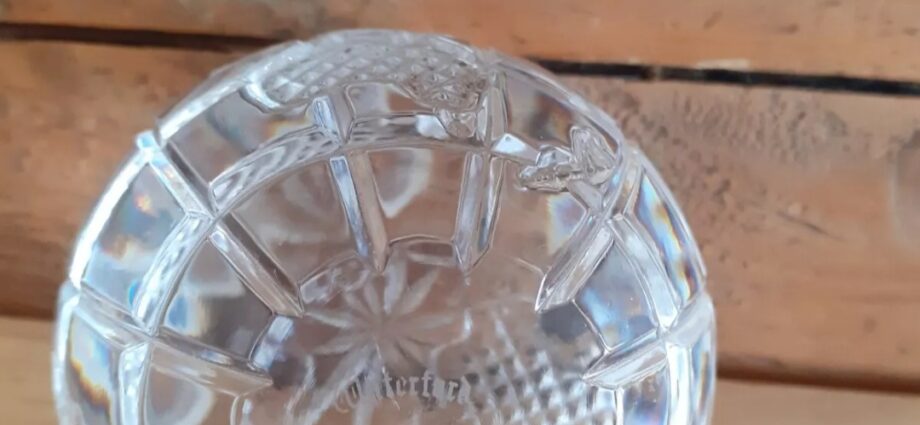
The Origins and Development of Waterford Crystal
The Founding of Waterford Crystal
Waterford Crystal’s history began in 1783 in Waterford, Ireland, when brothers George and William Penrose founded the company. The Penrose brothers were already well-established merchants and exporters, but they sought to create a new venture that would produce high-quality crystal glass. With skilled artisans and a strong demand for fine glassware, the brothers aimed to produce products that rivaled the glassware from the great manufacturers of Europe, especially Bohemia and England.
To achieve this, they hired renowned glassmaker John Hill, who brought expertise in producing lead crystal glass. Lead crystal, which contains at least 24% lead oxide, was highly prized for its brilliant clarity, heaviness, and ability to be cut and engraved. From the beginning, Waterford glass set itself apart with its meticulous craftsmanship and its ability to refract light in a way that created a stunning sparkle.
Early Success and Challenges
Waterford Crystal quickly gained a reputation for excellence, both locally and abroad. Its products included decanters, chandeliers, glasses, and bowls, all crafted with extraordinary attention to detail. By the early 19th century, Waterford glass was being exported to markets in Europe and the United States, where it was favored by wealthy customers and royalty alike.
Despite this initial success, the business was not without challenges. The Napoleonic Wars disrupted trade routes in the early 1800s, causing raw material shortages and financial strain. By 1851, these pressures forced the original Waterford Crystal factory to close. For over a century, Waterford lay dormant as the art of fine glassmaking languished in the region.
The Revival in the 20th Century
It wasn’t until 1947 that Waterford Crystal was revived by Czech immigrant Charles Bacik and Irishman Bernard Fitzpatrick. The two men reopened the factory, determined to restore the town’s legacy as a centre of crystal production. They reassembled a team of expert glassmakers, many of whom had trained in Europe, to reintroduce the traditional methods of hand-blown and hand-cut glass.
The company re-established itself quickly, producing timeless designs like the Lismore pattern, introduced in 1952. Named after a castle in County Waterford, Lismore became one of the company’s most iconic and recognisable patterns, featuring a series of elegant diamond and wedge cuts. Throughout the second half of the 20th century, Waterford continued to innovate while adhering to the traditions of craftsmanship that defined its reputation. Its product range expanded to include vases, paperweights, trophies, and even large-scale architectural pieces.
Waterford Crystal’s Global Legacy and Evolution
Waterford in the Modern Era
By the late 20th century, Waterford Crystal had grown into a global luxury brand, known for its quality and craftsmanship. It was not just used for fine dining but became synonymous with prestigious celebrations and events worldwide. Waterford chandeliers adorned some of the world’s most famous buildings, including Westminster Abbey and the Kennedy Center in Washington, D.C. In 1977, the company introduced a custom-made crystal ball for the New Year’s Eve celebrations in Times Square, New York City—a tradition that continues today.
In addition to its presence in public spaces, Waterford pieces became cherished heirlooms passed down through generations. The company’s distinctive designs, including the intricate cuts of the Lismore and Colleen patterns, made Waterford crystal instantly recognisable.
Mergers, Challenges, and Relocation
Despite its popularity, Waterford faced numerous challenges. Global economic shifts and changes in consumer preferences, especially after the 2008 financial crisis, had a significant impact on the luxury goods market. The company went through a series of ownership changes and mergers during this time. In 1986, Waterford merged with Wedgewood, another prestigious brand, to form Waterford Wedgwood.
However, by 2009, financial pressures led to Waterford Wedgwood entering receivership. The iconic Waterford factory in Ireland was closed, and the majority of its production was moved abroad, primarily to Slovenia and Germany. While the shift disappointed traditionalists, the company retained its commitment to quality, continuing to use the same skilled techniques, despite relocating much of its manufacturing.
Sustainability and Innovation
In recent years, Waterford Crystal has adapted to modern consumer trends, emphasising sustainability and ethical production practices. As demand for heritage brands and artisanal products grows, the company has expanded its product lines to cater to a more diverse, global market. Waterford has introduced limited-edition collections and collaborations with contemporary designers, ensuring that its rich heritage remains relevant to a younger generation.
Waterford continues to honour its roots by maintaining a visitor centre in Waterford, Ireland, where tourists can observe master glassblowers and cutters at work. Though much has changed since the company’s humble beginnings, Waterford Crystal remains a symbol of luxury, craftsmanship, and enduring beauty.
How to Verify a Genuine Waterford Crystal Piece
1. Look for the Waterford Acid Etched Mark
One of the easiest ways to verify a genuine Waterford crystal piece is by checking for the brand’s signature. Since the 1950s, all authentic Waterford pieces have been marked with an acid-etched logo, usually found on the base of the item. This mark typically reads “Waterford” in script, though some older or limited-edition pieces may have slight variations. Use a magnifying glass if needed, as the etching can be subtle.
For modern pieces, the mark may also include additional information, such as a date or limited-edition number. Be aware that while the acid-etched mark is a reliable indicator, it may have faded over time or been polished off in very old or well-used items.
2. Assess the Craftsmanship and Quality
Waterford crystal is known for its flawless craftsmanship. The crystal should feel heavy and sturdy in your hand. Authentic Waterford pieces are lead crystal, which gives them a weighty and substantial feel. The edges of a genuine Waterford crystal piece will be clean, sharp, and highly detailed, especially in patterns like Lismore or Colleen.
You should also examine the piece for clarity. Genuine Waterford crystal has brilliant clarity, with no air bubbles, impurities, or cloudiness. The cuts should be symmetrical and precise, reflecting light in a prismatic way that creates the signature “sparkle” Waterford is famous for.
3. Listen to the Sound Test
Waterford crystal produces a distinctive sound when gently tapped. You can perform a simple test by tapping the rim of a glass or vase with your fingernail or a wooden object. A genuine Waterford piece will emit a clear, ringing tone, often described as a bell-like sound. Imitation glass or lesser-quality crystal will typically produce a duller, less resonant sound.
4. Check the Packaging and Documentation
If the piece is new, it should come with official Waterford packaging and a certificate of authenticity. The packaging typically includes a box with the Waterford logo, and in some cases, it may also have the pattern name printed on the outside. Inside, there should be an information booklet or card detailing the product’s origins and craftsmanship.
For older or second-hand pieces, ensure that any documentation, such as receipts, certificates, or even original boxes, accompanies the item to help establish authenticity.
5. Visit an Authorised Retailer or Appraiser
When in doubt, purchasing from authorised Waterford retailers or getting an appraisal from a certified expert is one of the most reliable ways to verify authenticity. Many appraisers specialise in luxury glassware and can authenticate your piece based on its characteristics and history. Authorised retailers often have access to historical records and databases of Waterford patterns, helping you verify older or discontinued items.
6. Cross-Check with Waterford Crystal Patterns
Waterford’s vast array of patterns can also help identify authenticity. Iconic designs like Lismore, introduced in the 1950s, are still produced today and remain highly recognisable. Compare the cuts, design elements, and overall form of your piece with reference photos of known Waterford patterns. Some websites and books catalogue these designs, allowing you to match your piece against known Waterford models.
Verifying Waterford Crystal takes a bit of time and attention to detail, but the effort is well worth it to ensure you’re handling an authentic piece of history and luxury.
Wildcard Curiosities
For more informative blogs, our shop and all about who we are. Keep searching our website and check us out on social media @wildcardcuriosities
